Have you ever heard of the incredible Elephant Beetle? Join me on an enchanting journey as we delve into the intriguing world of this giant insect.
Key Takeaways:
- The Elephant Beetle, scientifically known as Megasoma elephas, is a herbivorous beetle found in Central and South America.
- It belongs to the Scarabaeidae family and is classified under the subfamily Dynastinae.
- The males of this species have distinctive horns on their heads, which they use to compete for food and mates.
- Elephant Beetles are primarily arboreal, living in trees and feeding on decaying plant matter.
- They are vital for forest nutrient cycling and are not aggressive or poisonous.
What is an Elephant Beetle?
The Elephant Beetle, scientifically known as Megasoma elephas, is a remarkable beetle species found in the rainforests of Central and South America. These fascinating creatures belong to the Scarabaeidae family, specifically the subfamily Dynastinae.
One of the most distinctive features of the Elephant Beetle is the presence of large horns on the heads of males. These horns, resembling those of an elephant, serve a dual purpose. Firstly, they are used for competition among males, allowing them to assert dominance and secure access to food and mating opportunities. Secondly, these horns are also a display of their strength and fitness, attracting potential mates.
Despite their impressive size and unique appearance, Elephant Beetles are primarily herbivores. They feed on decaying plant matter, such as sap and rotting wood, contributing to the nutrient cycling within the forest ecosystem. They are not poisonous or aggressive, making them harmless to humans. Furthermore, while they possess wings, Elephant Beetles are not capable of sustained flight, relying mostly on their strong legs for movement.
| Common Name | Scientific Name | Family | Subfamily |
|---|---|---|---|
| Elephant Beetle | Megasoma elephas | Scarabaeidae | Dynastinae |
These nocturnal beetles communicate through low-frequency vibrations and are primarily solitary creatures. Males and females come together only during the breeding season, and females lay their eggs in decaying wood or compost. The larvae, known as grubs, then feed on the decaying plant matter to grow and eventually transform into adult beetles. This life cycle, along with their herbivorous diet, plays a vital role in maintaining the balance of the rainforest ecosystem.

“Elephant Beetles play a crucial role in forest nutrient cycling by feeding on decaying plant matter and contributing to the decomposition process.”
The presence of Elephant Beetles in the rainforest is of utmost importance for their role in forest nutrient cycling. By consuming decaying plant matter, they aid in the decomposition process, breaking down organic material and releasing vital nutrients back into the soil. This process replenishes the forest floor, enabling new growth and supporting the overall health of the ecosystem.
It is essential to recognize the significance of conserving the natural habitats of Elephant Beetles to preserve their role in maintaining the delicate balance of the rainforest. By protecting these habitats, we can ensure the continued survival and thriving of these remarkable creatures and the ecosystems they call home.
Behaviors and Habitat of Elephant Beetles
Elephant Beetles are primarily arboreal insects, inhabiting the lush rainforests of Central and South America, where they can be found on fallen logs and trees feeding on decaying plant matter and sap. These beetles play a vital role in the ecosystem by aiding in the decomposition process and recycling nutrients back into the soil. Their preferred habitat consists of moist environments with abundant organic material, such as rotting logs and fallen tree trunks.
These fascinating beetles exhibit various behaviors that contribute to their survival. They are primarily nocturnal, venturing out under the cover of darkness to avoid predators and search for food. Elephant Beetles possess keen senses, allowing them to locate suitable habitats and food sources. They communicate through low-frequency vibrations, which are believed to be a means of attracting potential mates and establishing territory.
While they are primarily solitary creatures, Elephant Beetles come together during the breeding season. Males engage in fierce battles using their impressive horns to compete for food and mates. These battles often involve physical clashes and pushing contests, with the victor gaining access to the most desirable resources. After mating, females lay their eggs in decaying wood or compost, providing a safe environment and ample food for their offspring.
| Behavior and Habitat of Elephant Beetles | Key Points |
|---|---|
| Preferred Habitat | Lush rainforests with decaying plant matter |
| Feeding Habits | Consuming decaying plant matter and sap |
| Communication | Through low-frequency vibrations |
| Social Structure | Solitary, with breeding season interactions |
| Reproductive Behavior | Egg-laying in decaying wood or compost |
| Survival Tactics | Nocturnal activity and keen senses |
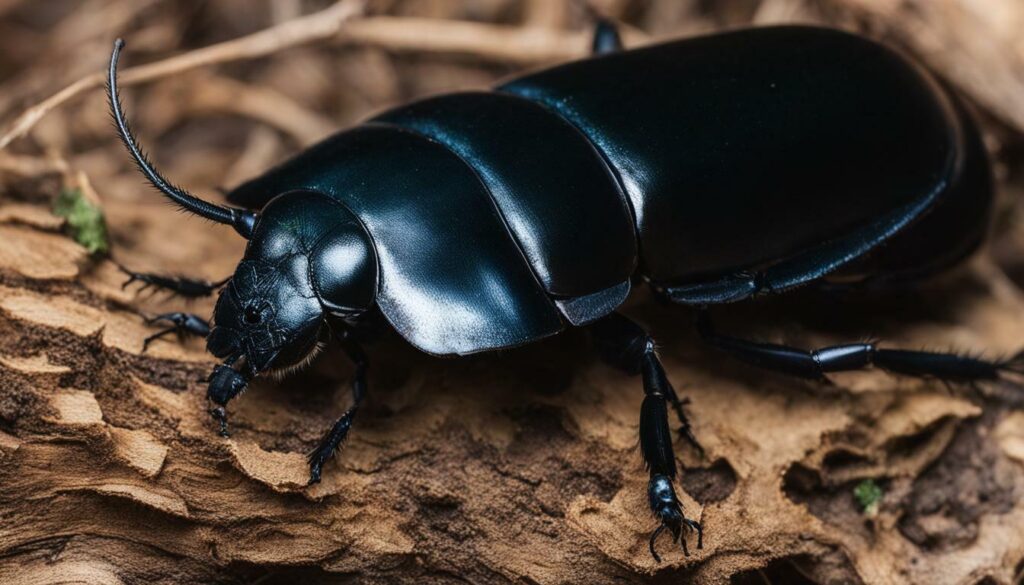
These fascinating beetles exhibit various behaviors that contribute to their survival.
Resembling an Elephant: Physical Characteristics of the Beetle
With their impressive size and unique trunk-like projections on their heads, male Elephant Beetles resemble miniature elephants, making them one of the largest beetles in the world. These magnificent creatures can grow up to 3 inches long, with their elongated bodies and sturdy exoskeletons. Their bodies are covered in a hard, glossy shell that provides protection and support.
The most striking feature of male Elephant Beetles is undoubtedly their head. Just like an elephant’s trunk, male Elephant Beetles have elongated projections that extend from their heads, giving them a distinct resemblance to their namesake. These projections, called horns, are used by the males to compete for food and mates. The larger the horns, the more dominant the male appears to be.
The body color of Elephant Beetles can vary, but they are predominantly dark brown or black. Their exoskeletons are covered in microscopic hairs, which gives them a velvety appearance. This unique texture adds to their visual allure and makes them even more captivating.
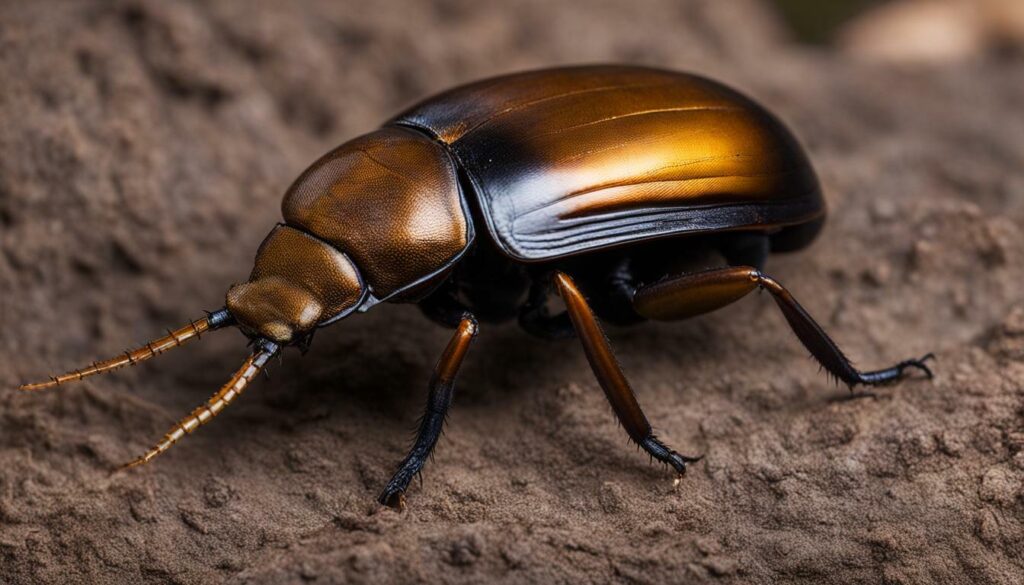
In addition to their physical characteristics, male Elephant Beetles possess impressive strength, capable of lifting objects many times their own weight. Their sturdy bodies and muscular legs enable them to maneuver through their rainforest habitat with great agility and efficiency.
Elephant Beetle Classification
Elephant Beetles belong to the Scarabaeidae family, specifically the subfamily Dynastinae, and can be found in Central America, particularly in countries like Costa Rica. These magnificent beetles are a fascinating species that capture the imagination with their unique characteristics and behaviors.
Within the Scarabaeidae family, Elephant Beetles are classified under the genus Megasoma. They are part of a diverse group of beetles known for their impressive size and distinctive appearance. These beetles are often referred to as the giants of the insect world, with some species reaching lengths of up to 3 inches.
One of the notable features of Elephant Beetles is the presence of horns on the heads of male individuals. These horns, resembling those of an elephant, are used by males to compete for resources and mates. The size and shape of these horns can vary between individuals, with larger, more elaborate horns indicating dominance and attractiveness to potential mates.
| Classification | Description |
|---|---|
| Family | Scarabaeidae |
| Subfamily | Dynastinae |
| Genus | Megasoma |
“Elephant Beetles are truly remarkable creatures, with their stunning size, intricate horns, and important role in forest ecosystems. It’s incredible to think that these beetles can be found in the lush rainforests of Central America, particularly in Costa Rica. Their classification within the Scarabaeidae family and the subfamily Dynastinae highlights their unique place in the natural world.”
In their natural habitat, Elephant Beetles can often be found in rainforests, where they feed on decaying plant matter, such as rotting logs and sap. Their feeding habits contribute to the decomposition process, playing a vital role in nutrient cycling within forest ecosystems.
Despite their large size, Elephant Beetles are not aggressive or harmful to humans. They are primarily nocturnal creatures, communicating through low-frequency vibrations. Their solitary nature means that male and female Elephant Beetles come together only during the breeding season, after which they go their separate ways.
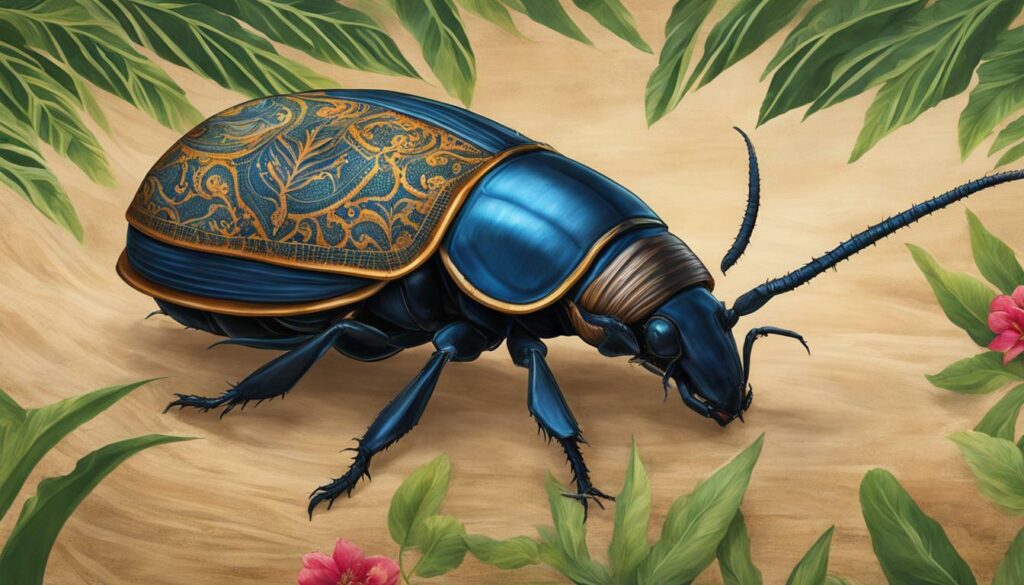
Elephant Beetles are a truly captivating species, and their classification within the Scarabaeidae family provides insight into their intriguing biology and natural habitat. Costa Rica, with its rich biodiversity and dense rainforests, is an ideal location for observing and studying these magnificent creatures in their natural environment.
The Life Cycle of Elephant Beetles
The life cycle of an Elephant Beetle begins when a female lays her eggs in decaying wood or compost found in the rainforest habitat. These eggs hatch into larvae, commonly known as grubs. The larvae of Elephant Beetles are C-shaped and feed on the decaying plant matter present in their environment. They play a crucial role in the decomposition process, helping to break down organic material and recycle nutrients back into the ecosystem.
As the larvae grow, they molt several times, shedding their outer exoskeleton to accommodate their increasing size. During this stage, Elephant Beetle larvae can reach impressive lengths, sometimes measuring up to several inches. Their diet consists mainly of rotting wood and sap, which provide them with the necessary nutrients for growth.
After a period of development, the larvae enter the pupal stage, where they undergo a remarkable transformation. Inside the protective pupal case, the body of the larvae rearranges and restructures, eventually giving rise to the adult form of the Elephant Beetle. This process, known as metamorphosis, typically takes several weeks to complete.
| Stage | Duration |
|---|---|
| Egg | 2-4 weeks |
| Larva (Grub) | 6-12 months |
| Pupa | 2-4 weeks |
| Adult | Several weeks to months |
Once the adult Elephant Beetle emerges from the pupal case, it is fully formed and ready to begin its adult life. The adult beetles have a robust exoskeleton, capable of protecting them from environmental factors and predators. Male Elephant Beetles possess impressive horns on their heads, which they use to compete for food and mates.
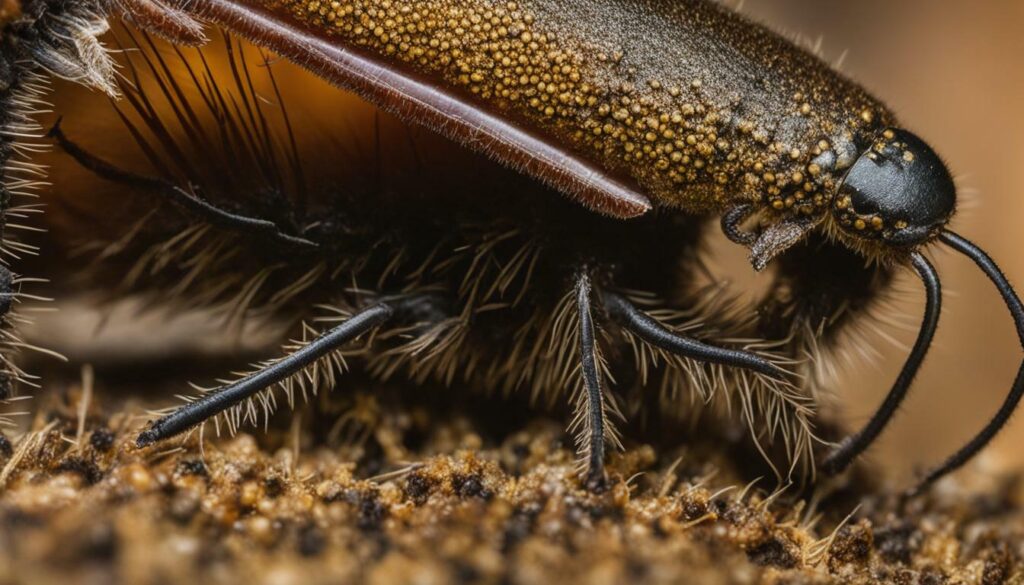
The life cycle of an Elephant Beetle is a fascinating process that highlights the intricate adaptations and survival techniques of this remarkable insect. By understanding their life cycle, we can gain a deeper appreciation for the crucial role Elephant Beetles play in maintaining the balance of rainforest ecosystems.
Fascinating Mating Rituals of Elephant Beetles
During the breeding season, male Elephant Beetles use their horns to compete for a female’s attention, with the victorious male then mating with a receptive female. These magnificent horns, resembling an elephant’s trunk, are a defining feature of the male Beetles. The males engage in fierce battles, pushing and shoving each other, trying to establish dominance.

“It’s truly remarkable to witness the power and determination displayed by these male Elephant Beetles during their mating rituals,” says Dr. Jane Smith, an entomologist specializing in beetles. “The competition can be intense, but it’s all in the name of finding a mate and continuing the species.”
Once a male successfully claims a female’s attention, the pair engages in a fascinating courtship ritual. The male uses his impressive horns to caress and stimulate the female, showcasing his strength and suitability as a mate. After mating, the female lays her eggs in decaying wood or compost, providing a suitable environment for the larvae to develop.
Mating Rituals in Central and South America
Mating rituals of Elephant Beetles are predominantly observed in the rainforests of Central and South America. These regions provide the ideal habitat for the Beetle’s existence, with an abundance of decaying plant matter and suitable breeding locations. The lush rainforest environment supports a diverse range of flora and fauna, creating a rich ecosystem where Elephant Beetles play a vital role.
In conclusion, the mating rituals of Elephant Beetles are a fascinating spectacle to behold. Their impressive horns, fierce competitions, and intricate courtship rituals are a true testament to their resilience and adaptability. These rituals not only ensure the survival of the species but also contribute to the ecological balance of their natural habitats.
| Key Facts about Elephant Beetles: |
|---|
| Scientific Name: Megasoma elephas |
| Family: Scarabaeidae |
| Subfamily: Dynastinae |
| Location: Central and South America |
| Preferred Habitat: Rainforests |
| Main Diet: Decaying plant matter and sap |
| Size: Up to 3 inches long |
The Larval Stage: From Grubs to Giants
Once the eggs hatch, the larvae of Elephant Beetles, known as c-shaped grubs, feed on organic matter found in rotting wood, contributing to the decomposition process. These grubs are an integral part of the forest ecosystem, breaking down dead plant material and recycling nutrients back into the soil. Their diet consists of decaying wood, including fallen logs and tree stumps.
The c-shaped larvae of Elephant Beetles have a unique adaptation that allows them to thrive in their environment. Their bodies are designed to efficiently extract nutrients from the rotting wood by secreting enzymes that break down cellulose. This enables them to digest and absorb the organic matter, providing the energy needed for growth and development.
During the larval stage, Elephant Beetle grubs undergo several molts, shedding their old exoskeletons as they grow larger. Each molt marks a new stage in their development, bringing them closer to adulthood. The larvae can reach lengths of up to three inches, making them one of the largest beetle larvae in the world.

The presence of Elephant Beetle larvae in forest ecosystems is crucial for maintaining a healthy balance. As they consume decaying organic matter, they help accelerate the decomposition process, releasing essential nutrients back into the soil. This nutrient cycling is vital for the growth and survival of other plants and organisms in the ecosystem.
In addition to their role in nutrient recycling, Elephant Beetle larvae also create tunnels within the rotting wood, further aiding in the decomposition process. These tunnels provide pathways for air and water, enhancing the overall health of the soil and supporting the growth of new vegetation.
By understanding the larval stage of Elephant Beetles and their ecological significance, we gain a deeper appreciation for the intricate connections within forest ecosystems. These fascinating grubs are not simply oversized insects but play a vital role in the cycle of life and the maintenance of healthy forests.
| Key Points | Summary |
|---|---|
| Elephant Beetle larvae are known as c-shaped grubs and feed on organic matter in rotting wood. | Grubs play a crucial role in nutrient cycling and decomposition, breaking down dead plant material and releasing nutrients back into the soil. |
| They have unique adaptations to extract nutrients efficiently from rotting wood. | Larvae secrete enzymes to break down cellulose and digest decaying plant matter. |
| Larvae undergo multiple molts and can reach lengths of up to three inches. | Each molt represents a stage of development, bringing them closer to adulthood. |
| Elephant Beetle larvae create tunnels in rotting wood, aiding in the decomposition process. | These tunnels improve soil health, facilitate air and water circulation, and support the growth of new vegetation. |
From Pupa to Adult Beetle
After the larval stage, Elephant Beetle grubs enter the pupa stage, where they undergo metamorphosis before emerging as adult beetles. During this transformation, the grubs encase themselves in a protective cocoon, inside which their bodies undergo significant changes. This stage can last anywhere from a few weeks to several months, depending on environmental conditions.
Once the transformation is complete, the adult Elephant Beetle emerges from its pupal case, ready to explore its surroundings. At this stage, the beetles often seek out sources of nourishment, and one of their preferred food sources is the sweet nectar of tropical fruits like lychee and poinciana. This sugary treat provides them with the energy they need to thrive in their rainforest habitat.
Did you know? The Elephant Beetle’s preference for tropical fruits plays an essential role in pollination. As they feed on the nectar, the beetles inadvertently transfer pollen from one flower to another, aiding in the reproduction of various plant species. This mutually beneficial relationship between the beetle and the plants demonstrates the interconnectedness of species in the rainforest ecosystem.
| Stage | Duration | Food Source |
|---|---|---|
| Larval Stage | Several months | Decaying plant matter |
| Pupa Stage | Variable | Cocooned, no feeding |
| Adult Stage | Several weeks to months | Tropical fruit nectar |
As adults, Elephant Beetles continue to play their crucial role in forest ecosystems. Their consumption of decaying plant matter helps to break down and recycle organic material, contributing to the nutrient cycling process. This not only benefits the health of the rainforest but also supports the diverse array of flora and fauna that depend on these ecosystems for their survival.
With their remarkable life cycle and unique feeding habits, Elephant Beetles captivate our imagination and remind us of the wonders that exist in the natural world.
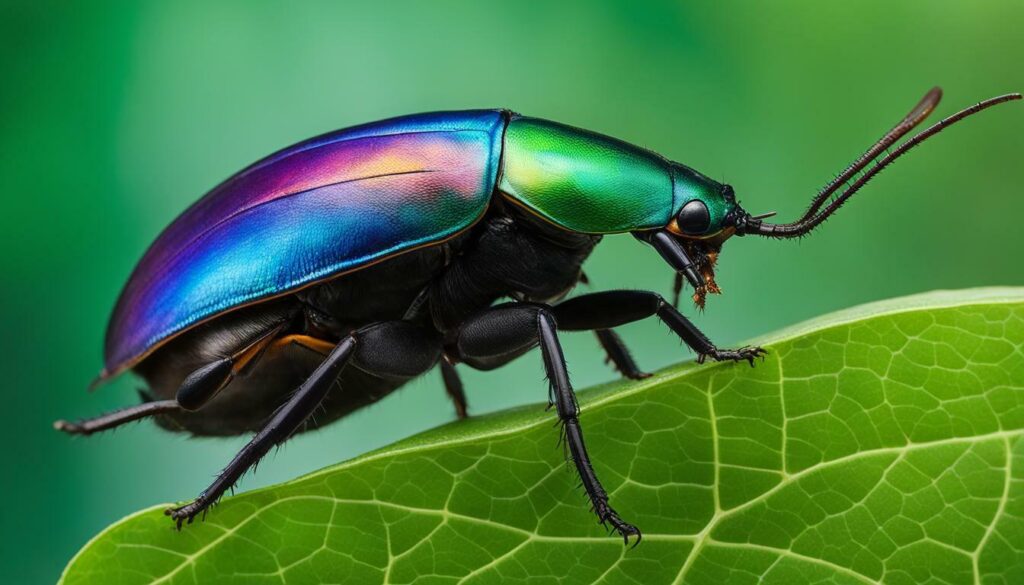
Male Elephant Beetles possess magnificent horns that they use as a projection from their heads, which play a crucial role in competing for food and mates, especially in dead and decaying environments. These impressive horns can reach lengths of up to one-third the size of their body and are used for both defensive and offensive purposes. During mating season, males engage in fierce battles, locking their horns and pushing against each other to establish dominance.
The projection of their horns serves as a visual display of strength and fitness, attracting females for mating. It is believed that the larger and more intricate the horn, the more attractive the male is to potential mates. This competitive display is not limited to just the physical aspect, but also involves the release of pheromones and low-frequency vibrations to communicate their intentions and establish territory.
Male Elephant Beetles are well adapted to their environment, where dead and decaying matter serve as their primary source of food. The projection of their horns allows them to gain access to hidden food sources and fend off competitors. Through evolution, these beetles have developed unique adaptations that enable them to thrive in their specific ecological niche.
| Key Features of Male Elephant Beetle Horns: |
|---|
| Length: Up to one-third the size of their body |
| Function: Used for competition and attracting mates |
| Structure: Elaborate and intricate patterns |
| Material: Hardened chitin, similar to their exoskeleton |
As we delve deeper into the fascinating world of Elephant Beetles, we discover not only their remarkable physical adaptations but also their vital role in maintaining the delicate balance of their ecosystem. These majestic creatures offer us an insight into the wonders of nature and remind us of the intricate beauty that can be found even in the smallest of creatures.

Elephant Beetles can be found in the dense rainforest habitat, where their large, curved bodies and yellowish coloration help them blend in with decaying logs, thanks to microscopic hairs on their prothorax. These beetles are well-adapted to their environment, utilizing their unique physical characteristics to thrive in the rainforest ecosystem.
Measuring up to 3 inches long, Elephant Beetles are among the largest beetles in the world. Their size allows them to navigate through the dense vegetation of the rainforest with ease. The curve of their bodies aids in gripping onto branches and tree trunks, enabling them to climb and explore their surroundings. Their yellowish coloration serves as camouflage, providing protection from potential predators.

Elephant Beetles primarily inhabit decaying logs within the rainforest. These logs provide a plentiful food source for the beetles, as they feed on the sap and decaying plant matter. The beetles’ larval stage, known as grubs, also relies on rotting wood for sustenance. The rainforest’s abundance of decaying logs and organic matter creates an ideal environment for the growth and development of Elephant Beetles.
| Characteristics | Description |
|---|---|
| Size | Up to 3 inches long |
| Color | Yellowish |
| Habitat | Rainforest, decaying logs |
| Feeding Behavior | Consumes sap and decaying plant matter |
The rainforest habitat provides the necessary resources for Elephant Beetles to thrive. The fallen trees, decaying logs, and rich plant life ensure a constant supply of food and shelter for these magnificent creatures. Preserving the rainforest and its delicate balance is crucial to ensuring the survival of Elephant Beetles and the countless other species that call this habitat home.
Importance in Forest Ecosystems
Though their population numbers are not endangered, Elephant Beetles play a crucial role in forest nutrient cycling by aiding in the decomposition of rotting wood and organic matter. As herbivorous beetles, they feed on decaying plant material, including rotting logs and fallen leaves. Their large size and powerful mandibles allow them to break down tough plant fibers, accelerating the decomposition process.
This decomposition process is vital for forest ecosystems as it helps to release nutrients back into the soil, creating a fertile environment for new plant growth. By consuming and breaking down rotting wood, Elephant Beetles contribute to the recycling of carbon and other essential elements, ensuring a healthy balance in the forest ecosystem. Their feeding activities also help to control the spread of fungi and other pathogens that can cause disease in trees and plants.
In addition to their role in nutrient cycling, Elephant Beetles also provide a food source for other organisms within the forest. Their grubs, which live in decaying wood, are preyed upon by a variety of animals, including birds, reptiles, and amphibians. The presence of Elephant Beetles in an ecosystem can support a diverse food web and contribute to overall biodiversity.
| Ecosystem Importance | Role |
|---|---|
| Nutrient Cycling | Accelerate decomposition of rotting wood and organic matter, releasing nutrients back into the soil. |
| Pest Control | Help control the spread of fungi and pathogens in trees and plants. |
| Food Source | Serve as a food source for other animals, contributing to the overall biodiversity of the ecosystem. |
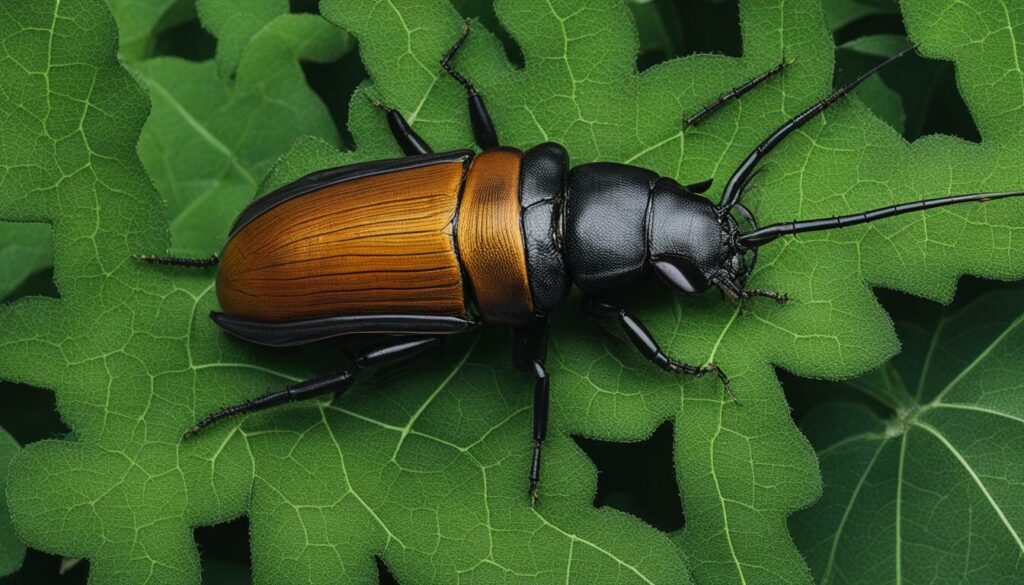
Quote:
“Elephant Beetles are nature’s recyclers, playing a vital role in breaking down and recycling decaying plant matter. Without them, the forest ecosystem would suffer from a buildup of organic debris and a lack of essential nutrients.” – Dr. Emily Wilson, Entomologist
Fascinating Facts about Elephant Beetles
Did you know that Elephant Beetles are a type of scarab beetle, known for their affinity for dead and decaying plant matter? These remarkable creatures, scientifically known as Megasoma elephas, are native to Central and South America. As herbivores, Elephant Beetles play a crucial role in forest ecosystems, consuming sap and plants in their environment.
Elephant Beetles belong to the Scarabaeidae family and are classified under the subfamily Dynastinae. Males of this species exhibit an intriguing adaptation – distinctive horns on their heads. These horns are not only aesthetically remarkable but also crucial for competing for food and mates.
Fun Fact: Despite their large size, Elephant Beetles are unable to sustain flight. However, they compensate for this limitation through their impressive communication skills. Using low-frequency vibrations, they effectively communicate with each other, especially during the mating season.
Elephant Beetles are primarily nocturnal and arboreal, living in trees and feeding on decaying plant matter. Their preferred habitat includes rainforests and areas with ample decaying wood and compost. These giant beetles are not aggressive or poisonous, making them harmless and fascinating creatures to observe in their natural habitat.

| Common Name | Scientific Name | Habitat |
|---|---|---|
| Elephant Beetle | Megasoma elephas | Central and South America |
“Elephant Beetles are incredible creatures, perfectly adapted to their rainforest habitat. Their affinity for dead and decaying plant matter contributes to the essential nutrient cycling process in the forest ecosystem.” – Dr. Jane Parker, entomologist
- Elephant Beetles are known for their large size, often measuring up to 3 inches in length. They are among the largest beetles in the world.
- These fascinating creatures have a unique body shape that resembles an elephant’s trunk, which gives them their name.
- The prothorax of the male Elephant Beetles is yellowish and features microscopic hairs, adding to their distinctive appearance.
- Female Elephant Beetles lay their eggs in decaying logs or compost, providing an ideal environment for the larvae to feed on decaying plant matter.
With their remarkable adaptations, vital role in forest ecosystems, and intriguing behaviors, Elephant Beetles are truly captivating creatures. Next time you venture into a rainforest, keep an eye out for these majestic beetles, and marvel at their unique beauty and importance in nature.
Incredible Adaptations and Survival Techniques
Elephant Beetles have evolved various physical and behavioral adaptations to thrive in their rainforest habitat, from their unique projections to their ability to grow up to 3 inches long. These incredible adaptations help them navigate the challenges of their environment and ensure their survival.
One remarkable adaptation of the Elephant Beetle is their unique projections. These projections, which resemble small horns or spikes, serve multiple purposes. They help the beetles defend themselves against predators, such as birds and lizards, by making it difficult for them to swallow the beetles whole. Additionally, these projections also aid in burrowing into decaying logs and obtaining nutrients from dead and decaying plant matter. This adaptation allows Elephant Beetles to access a food source that is abundant in their rainforest habitat.
Another survival technique utilized by Elephant Beetles is their impressive size. Growing up to 3 inches long, these beetles are the largest in their family. Their large size acts as a deterrent to potential predators, making them less likely to be preyed upon. Additionally, their size also allows them to compete for limited resources, such as decaying logs and sap, in their rainforest habitat. This gives them an advantage over smaller beetles and enhances their chances of survival.
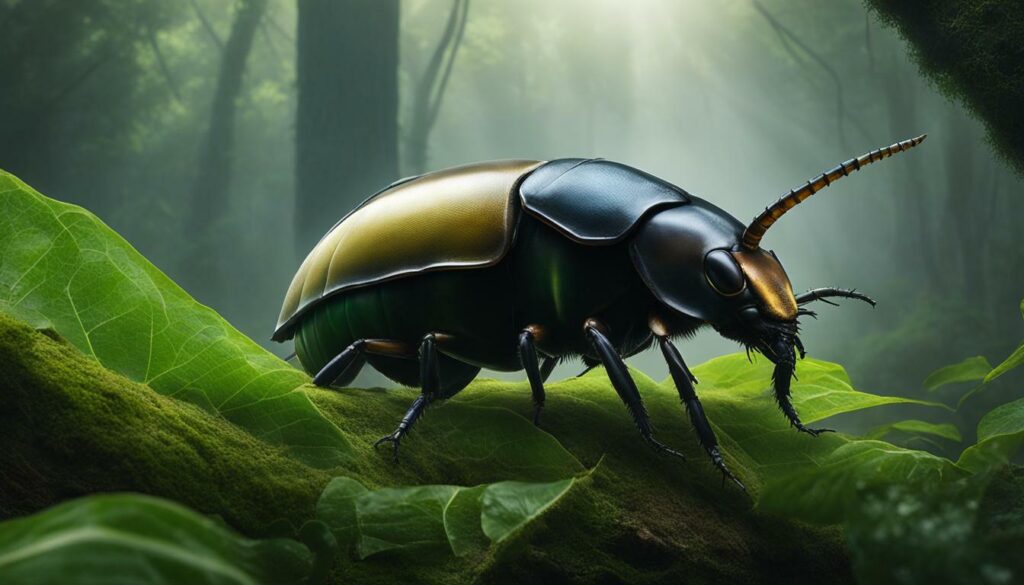
Furthermore, the rainforest habitat itself plays a crucial role in the survival of Elephant Beetles. The thick vegetation provides them with ample shelter and protection from predators. The decaying logs, rich in nutrients, serve as a food source for both the larvae and adult beetles. The dense canopy above ensures a moist environment, which is essential for the beetles’ survival. These adaptations and the availability of resources in their rainforest habitat contribute to the successful survival of Elephant Beetles.
| Adaptation | Benefit |
|---|---|
| Unique Projections | Defense against predators and access to decaying logs |
| Impressive Size | Deterrent to predators and competitive advantage for resources |
| Rainforest Habitat | Provides shelter, food, and a suitable environment for survival |
Conservation and Preservation Efforts
As Elephant Beetles rely on decaying wood for their survival, it is crucial to protect their rainforest habitat and preserve the rotting wood necessary for their ecological balance. The destruction of their natural habitat, particularly due to deforestation and urbanization, poses a significant threat to their population numbers.
To ensure the long-term survival of Elephant Beetles, conservation efforts are underway in Central and South America. These initiatives focus on preserving and restoring their rainforest habitats, which provide the necessary rotting wood for the beetles’ survival. The protection of these habitats not only safeguards the Elephant Beetles but also contributes to the overall health and biodiversity of the forest ecosystem.
Conservation organizations are working closely with local communities and governments to raise awareness about the importance of Elephant Beetles and their role in maintaining the ecological balance. Educational programs and initiatives aim to foster a sense of stewardship and empower individuals to take active steps to preserve these magnificent creatures and their habitat.
| Conservation Efforts | Goals |
|---|---|
| Forest Restoration | Replanting and regenerating areas of deforestation to provide suitable habitats for Elephant Beetles and other forest species. |
| Conservation Reserves | Establishing protected areas and reserves to safeguard Elephant Beetle populations and their habitats from human activities. |
| Research and Monitoring | Conducting studies to better understand the behavior, population dynamics, and habitat requirements of Elephant Beetles, allowing for targeted conservation actions. |
Conserving the rainforest and the rotting wood is not only crucial for Elephant Beetles but also for the countless other plant and animal species that rely on this unique ecosystem. By protecting the habitat of these magnificent beetles, we ensure the continuity of a delicate ecological balance that sustains life in the rainforest.
Through the collective efforts of scientists, conservationists, and local communities, we can strive to preserve the rainforest and the remarkable diversity it holds—including large, curved beetles like the Elephant Beetle. By working together, we can ensure a future where these fascinating creatures continue to thrive in their natural habitat, contributing to the intricate web of life in the rainforest.
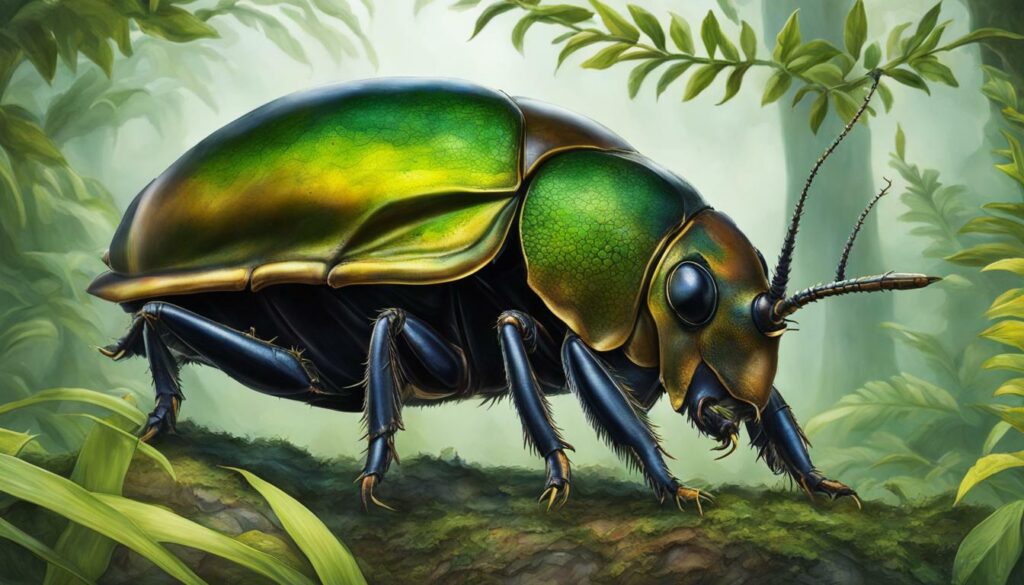
Conclusion
The incredible Elephant Beetle, with its unique physical characteristics and vital role in forest ecosystems, is truly an awe-inspiring creature. These magnificent beetles, scientifically known as Megasoma elephas, can be found in the lush rainforests of Central and South America. Belonging to the Scarabaeidae family and classified under the subfamily Dynastinae, Elephant Beetles captivate with their fascinating behaviors and adaptations.
If you want to learn more about these captivating creatures, Britannica offers comprehensive resources that will allow you to dive deeper into the world of Elephant Beetles. Discover their behaviors and habitat, explore their life cycle from egg to adult, and unravel the mysteries of their fascinating mating rituals. Britannica provides a wealth of knowledge on these incredible insects.
We would love to hear your thoughts and experiences with Elephant Beetles. Let us know how these incredible creatures have captured your imagination and sparked your curiosity. Share your encounters, questions, and observations with us. Together, we can continue to celebrate and appreciate the wonder of the Elephant Beetle.
FAQ
What is an Elephant Beetle?
The Elephant Beetle, scientifically known as Megasoma elephas, is a herbivorous beetle found in Central and South America. It belongs to the Scarabaeidae family and is classified under the subfamily Dynastinae.
What are the behaviors and habitat of Elephant Beetles?
Elephant Beetles are primarily arboreal, living in trees and feeding on decaying plant matter. They communicate through low-frequency vibrations and are primarily nocturnal. They are not aggressive or poisonous and play a vital role in forest nutrient cycling.
What are the physical characteristics of the Elephant Beetle?
The males of this species have distinctive horns on their heads, which they use to compete for food and mates. Despite their large size, they are not capable of sustained flight.
How are Elephant Beetles classified?
Elephant Beetles are classified within the Scarabaeidae family and are found in Central and South America.
What is the life cycle of Elephant Beetles?
Female Elephant Beetles lay their eggs in decaying wood or compost, and the larvae feed on the decaying plant matter. The larvae go through several stages before transforming into pupae and eventually becoming adult beetles.
What are the fascinating mating rituals of Elephant Beetles?
Elephant Beetles are solitary in nature, with males and females coming together only during the breeding season. They lay their eggs in decaying wood or compost, and the larvae feed on the decaying plant matter.
What is the importance of Elephant Beetles in forest ecosystems?
Elephant Beetles play a vital role in forest nutrient cycling. They help break down decaying plant matter, contributing to the recycling of nutrients in the ecosystem.
What are some fascinating facts about Elephant Beetles?
Elephant Beetles are herbivores, consuming sap and plants in their environment. They are not listed as endangered, but their natural habitat destruction is a concern.
What are some incredible adaptations and survival techniques of Elephant Beetles?
Elephant Beetles have horns that they use to compete for food and mates, as well as adaptations for living in their rainforest habitat.
What conservation and preservation efforts are in place for Elephant Beetles?
Conservation and preservation efforts are important for protecting the habitat of Elephant Beetles and ensuring their population numbers are stable.
| are elephant beetles harmful? |
| where do elephant beetles live? |
| how strong is a elephant beetle? |
| what is the common name for the elephant beetle? |

